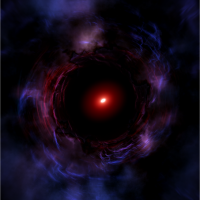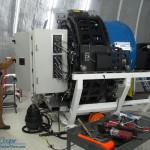W. M. Keck Observatory press release…

This research publishes today in the journal Nature, with Professor Karl Glazebrook, director of Swinburne’s Centre for Astrophysics and Supercomputing , as the lead author. To characterize the faint galaxy, the discovery team used MOSFIRE, the most in-demand instrument on the 10-meter Keck I telescope.
“This observation was only possible due to the extreme sensitivity of the new MOSFIRE spectrograph,” said Glazebrook. “It is the absolute best in the world for faint near-IR spectra by a wide margin. Our team is indebted to the accomplishment of Chuck Steidel, Ian McClean, and all the Keck Observatory staff for building and delivering this remarkable instrument.”
Astronomers expect most galaxies from this epoch to be low-mass minnows, busily forming stars. However, this galaxy is ‘a monster’ and inactive.
The researchers found that within a short time period this massive galaxy, known as ZF-COSMOS-20115, formed all of its stars (three to five times more than our Milky Way today) through an extreme star-burst event.
But it stopped forming stars only a billion years after the Big Bang to become a quiescent or ‘red and dead’ galaxy – common in our Universe today, but not expected to exist at this ancient epoch.
The galaxy is also small and extremely dense, it has 300 billion stars crammed into a region of space about the same size as the distance from the Sun to the nearby Orion Nebula.
Astrophysicists are still debating just how galaxies stop forming stars. Until recently, models suggested dead galaxies or ‘red nuggets’ such as this should only exist from around three billion years after the Big Bang.
“This discovery sets a new record for the earliest massive red galaxy. It is an incredibly rare find that poses a new challenge to galaxy evolution models to accommodate the existence of such galaxies much earlier in the Universe,” said Glazebrook.
This research builds on an earlier Swinburne study that suggested such dead galaxies could exist based on finding dim red objects in extremely deep near-infrared images.
MOSFIRE spectrograph studies the faintest, most distant galaxies
In this latest study, astronomers used the Keck Observatory telescopes to confirm the signatures of these galaxies, through the new and unique MOSFIRE spectrograph. They took deep spectra at near-infrared wavelengths to seek out the definitive features signifying the presence of old stars and a lack of active star formation.
“We used the most powerful telescope in the world, but we still needed to stare at this galaxy for more than two nights to reveal its remarkable nature,” said co-author Professor Vy Tran, from Texas A&M University.
Even with large telescopes such as Keck Observatory’s 10-meter mirror, a long viewing time is required to detect absorption lines which are very weak compared to the more prominent emission lines generated by star-forming active galaxies.

The observed star-formation rate of this galaxy produces less than one fifth the mass of the Sun a year in new stars, but at its peak 700 million years previously this galaxy formed 5000 times faster.
“This huge galaxy formed like a firecracker in less than 100 million years, right at the start of cosmic history,” Professor Glazebrook says. “It quickly made a monstrous object, then just as suddenly it quenched and turned itself off. As to how it did this, we can only speculate. This fast life and death so early in the Universe is not predicted by our modern galaxy formation theories.”
Co-author Dr. Corentin Schreiber of Leiden University, who first measured the spectrum, speculates that these early firecrackers are obscured behind a veil of dust and that future observations using sub-millimeter wave telescopes will spot these.
”Sub-millimeter waves are emitted by the hot dust which blocks other light and will tell us when these firecrackers exploded and how big a role they played in developing the primordial universe,” says Dr. Schreiber.
With the launch of the James Webb Space Telescope in 2018, astronomers will be able to build up large samples of these dead galaxies due to its high sensitivity, large mirror, and the advantage of no atmosphere in space.

